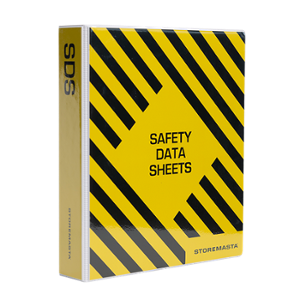When dealing with hazardous chemicals and dangerous goods in the workplace, awareness about the hazards that they present is crucial for work health and safety. To correctly identify chemical hazards, you’ll need documentation from the chemical manufacturer or supplier that guides you on how to accurately identify hazards and take the necessary precautions to minimise risk. This is where the Safety Data Sheet, or SDS, comes in.
In this post, we explain how to use an SDS to identify an array of chemical hazards that you may find at your own job site.
REMEMBER: Safety Data Sheets are an important part of the chemical risk management process, but you still need to follow the requirements of Australian Safety Standards, Codes of Practice, and WHS legislation.
What is an SDS?
A Safety Data Sheet is an internationally recognised document that outlines the physical and chemical properties of hazardous chemicals.
Each Safety Data Sheet follows a consistent and recognisable format set by the GHS, or Globally Harmonised System of Classification and Labelling of Chemicals. This means that you can quickly identify any acute health risks and physical hazards that could affect the health and safety of your workers, your property, or the environment.
How Do You Use an SDS?
When referring to your Safety Data Sheet, you must become familiar with the format of the chemical safety document. SDS are laid out in a methodical way, with a range of essential information under specific sections of the document.
Safety Data Sheets include the following information about the chemical hazards associated with your products.
These chemical hazards are:
- Health risks
- Physical hazards
- Environmental impacts
We’ll now go into further detail about how you can determine each of these hazards through referencing the correct section of your Safety Data Sheet.

The health risks, physical hazards and environmental impacts of your chemicals must be understood so they can be controlled and managed in the workplace.
Identifying Chemical Health Hazards
Hazardous chemicals can produce a wide range of acute and chronic illness or diseases ranging from burns to the skin, poisoning (if swallowed), and respiratory diseases.
The severity of any chemical exposure incident is impacted by the toxicity of the chemical, how the substance entered the body, how much of the chemical was absorbed or inhaled, and the duration of exposure. There are other factors too, (allergies, age, weight, BMI) but they usually won’t be indicated on a Safety Data Sheet.
Need safer chemical storage?
Get all the info you need in our Ultimate Handbook
There are various key sections of your Safety Data Sheet that can help you identify chemical health hazards:
Section 2: Hazard Identification
This section outlines the hazards of the chemical and offers the mandatory warning information. Section 2 of your Safety Data Sheet will explain if the chemical is toxic, corrosive, or carcinogenic. Further information about how the hazardous chemical could impact human health is found in Sections 4 and 11.
Section 4: First Aid Measures
In the First Aid Measures section of your Safety Data Sheet, you can find information on any immediate effects of the chemical (by the different routes of exposure) and the immediate treatment.
First aid measures will include information on emergency decontamination, for example, when to wash out eyes after chemical exposure.
Routes of exposure include:
- Inhalation: breathing in chemical vapours, fumes, mists, dusts, and other gases.
- Skin: chemicals contacting the skin through spills, splashes, or falling into a tank.
- Eyes: getting chemicals in the eyes.
- Ingestion: swallowing an unknown substance by mistake or ingesting spilled/released chemicals that have settled on hands, beards, cigarettes, cups, food.
The First Aid Measures section should also include any delayed effects and specific health surveillance. For example, IF IN EYES: Rinse cautiously with water for several minutes. Remove contact lenses, if present and easy to do. Continue rinsing.
REMEMBER: Chemicals can change forms and create additional health hazards that may not be fully covered in the Safety Data Sheet. For example an SDS for diesel fuel will list the health effects from inhaling vapours and fumes, but may have very little data about exposure to diesel exhaust and other emissions.
Section 8: Exposure Controls and Personal Protection
You should also check the SDS to see if the chemical has a Workplace Exposure Standard. Safe Work Australia have set official Workplace Exposure Standards for more than 700 hazardous chemicals used in Australian workplaces. The standards define the acceptable airborne concentration levels.
To meet these acceptable and legal limits for hazardous airborne contaminants, you may have to implement a range of controls to improve air quality in your workpace.
For example, work areas for commercial cleaners using chlorine bleach must never exceed 3mg/m3. To achieve this you may need to introduce engineering controls (like a mechanical ventilation system) or work procedures (diluting the concentration of chlorine) to keep the work areas within exposure standards.
Section 11: Toxicological Information
This section will outline the toxicity of the chemical and details things like acute toxicity, corrosiveness, carcinogenicity, or able to cause damage to the reproductive system. This section also details both acute and chronic health effects and may also include details of interactive effects (like drinking alcohol or having allergies).
The level of exposure is a crucial factor when determining risk. Health effects will be impacted by:
- Duration:(the period of time a worker is exposed to the chemical). The longer the exposure the greater the danger eg, a full-time commercial cleaner using chlorine bleach 40 hours per week vs a warehouse employee cleaning the floor of the storeroom with chlorine bleach once a month for an hour.
- Dose:(how much of the chemical is being used). This will be a combination of the volume of chemical being used, the dilution/purity, and the work area. Eg, a commercial cleaner using a heavily diluted chlorine bleach for 40 hours per week cleaning concrete tiles outdoors, may be in less danger than the warehouse employee (cleaning for one hour) using a strong mix of bleach in a small room without ventilation.
- Reactions and interactions: (incompatible substances present in the work areas)some chemicals are incompatible with other substances and are capable of creating dangerous chemical reactions or other toxic Eg, chlorine bleach and ammonia used together can produce an extremely toxic chemical, you may need to introduce safe operating procedures that ensure cleaning staff don’t mix these two chemicals. Always check Section 10: Stability and Reactivity of the Safety Data Sheet for details of incompatible materials and conditions to avoid.
IMPORTANT: Even when a Safety Data Sheet lists ‘no available data’ in the toxicology section (particularly chronic health effects), you should still exercise caution when using the chemical. It can be difficult to gauge the long-term exposure risks of any chemical and things like liver damage, reproductive issues, or cancer may take years to develop. Remember, the longer the exposure, the greater the danger.
Understanding Physical Hazards and Fire Risks
In addition to the chemical hazards which can directly affect human health, your onsite chemical may also have a physical hazard that you must control.
Physical hazards of chemicals may include the ability to:
- Burn or cause a fire
- Explode or release high pressure that could injure someone or damage property.
- Spontaneously react (either by itself or in contact with water)
There are multiple sections in the SDS which will help you identify physical hazards. The first place to start is Section 2: Hazard identification.
 You must keep your SDS in a visible, secure location so staff can quickly access important information about physical, health and environmental hazards.
You must keep your SDS in a visible, secure location so staff can quickly access important information about physical, health and environmental hazards.
Section 2: Hazard Identification
In this section of your Safety Data Sheet, you can quickly determine:
- The hazard class of the substance ie. Flammable Liquid – Category 1
- The way the substance could cause a dangerous event, with the possibility of fatalites. For example, heating of the hazardous chemical may result in a fire
- Precautionary measures for its handling and storage ie. Keep the flammable liquid away from ignition sources, such as heat, sparks, flames, hot surfaces
Once you’ve identified the initial hazard (fire, explosion, reaction) you’ll need to look more closely to determine what type of dangerous events the chemical could cause at your worksite.
Check the following sections of the Safety Data Sheet to further understand how to manage the potential for chemical hazards in your workplace:
Section 5: Firefighting Measures
You should definitely check this section even if the substance itself is not flammable. You will learn how the chemical reacts in a fire (eg, produces oxides of sulphur and nitrogen on combustion) and if you need any special fire-fighting equipment.
Section 9: Physical and Chemical Properties
This section of your SDS will explain the physical and chemical properties of your substance. If you determine that your chemical is flammable, you should also check the flashpoint in this section so you know what temperature is sufficient for flammable vapours to ignite in the presence of an ignition source.
Section 10: Stability and Reactivity
This section of your Safety Data Sheet describes any conditions that could cause the chemical to react or polymerise (eg, dust explosions, reactions that release flammable or toxic gases or vapours).
Section 10 will also detail if the chemical has any properties that may add to the intensity of a fire (even if the substance itself is non-flammable).
Section 14: Transport Information
Section 14 of your SDS is a section commonly used to determine the substance’s hazard class. Here, you’ll find the transport hazard class (or classes) for your chemical, as well as the assigned packing group.
The transport information section also includes important information such as the UN number, proper shipping name, environmental hazards and hazchem code.
Further Research
While the Safety Data Sheet is a starting point in your hazard identification processes, you should always conduct further research. This is especially relevant if the SDS indicates the chemicals are also classed as Dangerous Goods under the ADG Code. You can also look in Section 16. Other information for further information about relevant Australian Standards and legislation that apply to the chemical.
IMPORTANT: The signal words DANGER or WARNING quickly indicate the severity of a hazard — they will be listed on the SDS. DANGER indicates a significant hazard that must be avoided in order to prevent death or serious injury; WARNING indicates a hazard that is less urgent but still requires proper precautions.
Determining Environmental Impacts of Chemicals
Many hazardous chemicals can negatively affect the environment through emissions, hazardous waste, or toxins entering the soil and waterways. Chemicals with environmental hazards will either display the hazard code GHS09 environment or the international pictogram which depicts a dead tree, damaged waterway, and dead fish in the hazard section of the SDS.
Apart from the hazards section, the SDS will have a number of areas that specify risks to the environment.
However, you will be mainly referring to Section 12: Ecological information.
Section 12: Ecological Information
This section of your SDS contains essential information about the ecological hazards associated with your hazardous chemical.
Section 12 includes hazard information about:
- Ecotoxicity - whether the chemical is toxic to aquatic organisms (fish, crustaceans, algae and other aquatic plants) or terrestrial organisms (birds, bees and plants, soil micro and macro-organisms).
- Persistence and degradability - how easily the chemicals breakdown or metabolise eg, persistent chemicals can accumulate in soil and waterways. Some hazardous chemicals can degrade in the environment through processes like oxidation or hydrolysis eg, pesticides.
- Bioaccumulative potential - this mouthful of a term refers to a chemical’s ability to accumulate in the body of a human or animal and pass through the food chain. Chemicals like lead and mercury usually have bioaccumulative potential.
- Mobility in soil - this describes how easily the chemical could be absorbed into soil.
- Other adverse effects - usually refer to the chemical’s potential to deplete the ozone layer or contribute to global warming.
Because the data is presented as a summary (and often no more than a statement of a few words eg, Highly Mobile) you should also check:
Section 6: Accidental Release Measures
Summarises a response to a chemical spill, leaks or any other unplanned release of the chemical. Apart from protective measures for staff and clean up methods, this section also lists any environmental precautions (eg, Prevent run-off into drains and waterways). The greater the spill, the greater the potential damage to the environment.
Section 13: Disposal Considerations
Chemical waste can have a big impact on the environment and this section outlines the proper disposal or recycling of the hazardous chemical. You can gain a better understanding of the physical properties of a substance likely to affect disposal and any special precautions for sewerage, incineration or landfill.
IMPORTANT: Part of your risk management approach will be to determine the potential your organisation has to impact the environment — this is determined by quantities of chemicals used at your worksite. For example, a chemical manufacturing plant with 900 employees has a far greater potential to adversely impact the environment than a vehicle repair shop that employees 3 mechanics.
Understanding your Safety Data Sheet to Minimise Chemical Hazards
Using Safety Data Sheets to identify chemical hazards is only one step in the risk management process. It’s also crucial that you understand how to control these hazards so you can protect your workplace and your community. One of the key controls that you can introduce to minimise chemical hazards is compliant chemical storage — with your up-to-date SDSs located nearby (preferably in a liquid-tight document holder).
To find out more about protecting your workplace against chemical hazards, you can purchase our latest handbook. Our comprehensive guide offers detailed advice on hazardous chemicals, risk assessment, storage, SDS and emergency decontamination. Get your copy today and help create a safer, more compliant work environment.

Living life by the 4 C’s of marketing – communication, coffee, compliance… and more coffee – Leisa Andersen is Storemasta’s Content Marketing Manager. When she’s not writing, you’ll find her enjoying all the good things in life, including shopping, travel and gluten free donuts.

